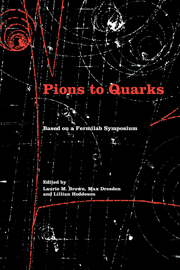Book contents
- Frontmatter
- Contents
- List of contributors
- Foreword by Leon M. Lederman
- Editors' acknowledgments
- Photographs of the symposium
- List of abbreviations
- List of notation
- I Introduction
- II Particle discoveries in cosmic rays
- III High-energy nuclear physics
- IV The new laboratory
- V The strange particles
- VI Weak interactions
- VII Weak interactions and parity nonconservation
- VIII The particle physics community
- IX Theories of hadrons
- X Personal overviews
- 45 Scientific impact of the first decade of the Rochester conferences (1950–1960)
- 46 Some reflections on the history of particle physics in the 1950s
- 47 Progress in elementary particle theory, 1950–1964
- Name index
- Subject index
45 - Scientific impact of the first decade of the Rochester conferences (1950–1960)
Published online by Cambridge University Press: 07 May 2010
- Frontmatter
- Contents
- List of contributors
- Foreword by Leon M. Lederman
- Editors' acknowledgments
- Photographs of the symposium
- List of abbreviations
- List of notation
- I Introduction
- II Particle discoveries in cosmic rays
- III High-energy nuclear physics
- IV The new laboratory
- V The strange particles
- VI Weak interactions
- VII Weak interactions and parity nonconservation
- VIII The particle physics community
- IX Theories of hadrons
- X Personal overviews
- 45 Scientific impact of the first decade of the Rochester conferences (1950–1960)
- 46 Some reflections on the history of particle physics in the 1950s
- 47 Progress in elementary particle theory, 1950–1964
- Name index
- Subject index
Summary
Introduction
The first Rochester conference on high-energy nuclear physics was held 16 December 1950, twenty months after the last of the three Shelter Island conferences on the foundations of quantum mechanics, organized by Robert Oppenheimer (1947–9). Five high-energy accelerators (“high energy” was defined as > 100 MeV thirty-five years ago!) had been completed since the end of World War II and were producing research results: two at Berkeley (340–MeV synchrocyclotron and 300-MeV electron-synchrotron), the Rochester 240-MeV and Harvard 150-MeV synchrocyclotrons, and the Cornell 300-MeV electron-synchrotron. Many more accelerators with even higher energies were under construction. Cosmic-ray experimentalists throughout the world were making extremely important contributions to the field.
It seemed clear to me that the Shelter Island conferences – which had been limited to a small number of theorists, with a couple of “token” experimentalists – should be replaced by a new series of conferences that would give equal weight to the participation of accelerator experimentalists, cosmicray experimentalists, and theorists. As the newly installed chairman of the Rochester Physics Department – with one of the few meson-producing machines in operation and a very active cosmic-ray group – I decided to organize an invitational conference that would thoroughly discuss the latest developments in high-energy physics.
The first two Rochester conferences were small (fifty to seventy-five participants), were of short duration (two days), were supported by local industry, and still were not truly international (Europe and Japan were recovering from the war). Their success and the increasing worldwide interest in the field led to the raising of sights in all respects.
- Type
- Chapter
- Information
- Pions to QuarksParticle Physics in the 1950s, pp. 645 - 667Publisher: Cambridge University PressPrint publication year: 1989
- 2
- Cited by



